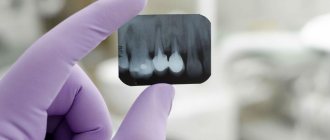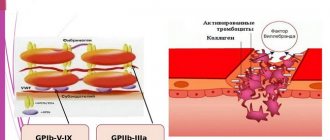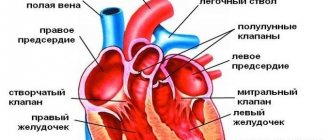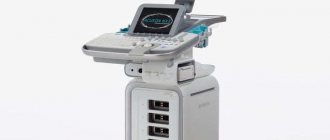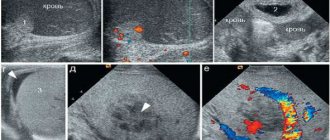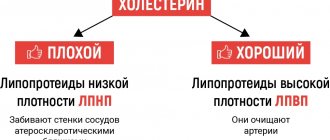II. Assess the degree of development of muscles, fat and bones using somatoscopy.
Somatoscopy. Plantography.
Goal of the work:
1). Determine and evaluate body shape by external examination (somatoscopy method);
2). Determine the degree of development of body components (muscles, fat and bones) using somatoscopy;
3). Master the technique of assessing the shape of the foot in various ways using a plantogram.
Equipment: calculator, ruler, pencil, triangle.
Progress:
I. Assess your body shape using somatoscopy.
1). Assess the shape of the chest.
Depending on the position of the sternum and ribs, there are four main types of chest and three abnormal ones (Table 2). Each type has a corresponding score.
Using Table 1, find your chest type and its development score. Record the result in the Somatoscopic Examination Protocol.
Table 1.
| Main types | Types of chest | Type description | Point |
| 1. Flat | When viewed from the side: the front wall is located vertically; small anteroposterior diameter; When viewed from the front: the chest is long, narrowed, the subcostal angle is acute | 1 | |
| 2. Flattened | From the side: the anteroposterior diameter is small, better developed in the transverse direction (quite wide when viewed from the front) | 1–2 | |
| 3. Cylindrical | From the side: wide, anteroposterior diameter well developed; uniformly widened in front (reminiscent of a barrel); subcostal angle - straight | 3 | |
| 4. Conical | From the side: the contour of the anterior wall is inclined anteriorly and downward, smoothly blending into the contour of the abdomen; The anteroposterior diameter approaches the transverse diameter; anteriorly: subcostal angle is obtuse, chest expands downwards | 4 | |
| Abnormal | 5. Keel-shaped (chicken) | Anterior: compressed from the sides, the sternum protrudes forward in the form of a keel | 0 |
| 6. "Shoemaker's Chest" | The chest is flat, the sternum seems to be depressed | 0 | |
| 7. Asymmetrical | Asymmetry of the left and right halves | 0 |
2). Assess the shape of the back by the degree of curvature of the spine, the position of the shoulder blades and the development of muscle tone. Using Table 2, find the type of back shape and the score of its development. Record the result in the Somatoscopic Examination Protocol.
table 2
| Types | Description | Point |
| 1. Straightened | It is characterized by the smoothness of all curves of the spinal column and the contours of the shoulder blades. Muscle tone is usually reduced. | 1 |
| 2. Normal | Average severity of all curves of the spine and the contour of the shoulder blades. This shape of the back is observed with well-defined muscle tone. | 2 |
| 3. Slouched (round) | It is characterized by a noticeable protrusion of the thoracic spine backwards and a forward tilt of the cervical spine. The corners of the shoulder blades protrude. This form of the back is observed in people with weak muscle tone. | 1 |
| 4. Round-concave (kyphotic) | Characterized by a simultaneous increase in thoracic kyphosis and lumbar lordosis; the angle of inclination of the pelvis is increased; the stomach is protruded, the buttocks protrude back. | 1 |
| 5. Plano-concave (lordship) | Characterized by increased only lumbar lordosis | 1 |
| 6. Scoliotic | It is characterized by lateral curvature of the spinal column, asymmetry of the shoulder girdles, shoulder blades and waist triangles. | 1 |
3). Determine the type of posture.
Posture is the habitual posture of a casually standing or sitting person (without active muscle tension). Posture is assessed by the position of body parts and the severity of the curves of the spine (Table 3). Record the result in the Somatoscopic Examination Protocol.
Table 3
| Types of Posture | Type description |
| 1. Correct (normal) | Observed with average and strong muscle development. The head is positioned straight, the chin looks forward; shoulders straightened, at the same level, shoulder blades pressed, stomach straight, legs straight. The curves of the spine are moderate and balanced. |
| 2. Straightened | The curve of the spine is smoothed. The back is straight. |
| 3. Slouched | Thoracic kyphosis and cervical lordosis are sharply expressed; the chest is flattened; shoulders pulled forward, chin down |
| 4. Lordish | Increased lumbar lordosis; strengthened lumbar curve; the belly is protruding or drooping; the cervical curve is smoothed |
| 5. Kyphotic | Strengthened cervical and lumbar lordosis; shoulders pulled forward; head down; the stomach protrudes; elbow and knee joints are bent |
| 6. Scoliotic | Lateral curvatures of the spine give an asymmetry in the position of the shoulders, shoulder blades, and collarbones; one of the waist triangles is smoothed; when standing, the support on one leg is strengthened |
4). Assess the shape of the abdomen . There are three main forms (see table 4). Using the table, find the type of abdominal shape and the score of its development. Record the result in the Somatoscopic Examination Protocol.
Table 4
| Belly types | Description | Point |
| 1. Sunken | It is characterized by a complete absence of subcutaneous fat tissue and weak muscle tone of the abdominal wall. The relief of the pelvic bones is clearly visible. | 1 |
| 2. Straight | This form of abdomen is characterized by significant development of the abdominal muscles and its good tone. Fat deposition is weak or moderate, the relief of the pelvic bones is smoothed. | 2 |
| 3. Convex | Characterized by abundant development of the subcutaneous fat layer. Muscle development may be weak or moderate. With a convex abdomen, a fat fold often appears located above the pubis. The bony relief of the pelvic bones is completely smoothed and is often difficult to palpate. | 3 |
5). Assess the shape of your legs. There are 3 types - straight legs, X-shaped and O-shaped (Table 5). Using the table, find the type of leg shape and the degree of its deviation from straight lines. Record the result in the Somatoscopic Examination Protocol.
Table 5.
| Types | Description | Degree (in points) |
| 1. Straight | The legs touch each other at the hips, knees and ankles. With developed calf muscles - and in the lower leg area | – |
| 2. X-shaped (valgus type) | They touch at the knees, but do not touch at the hips and ankles (or only the ankles - in case of obesity) | 1 – 3 * (X1 – X3) |
| 3. O-shaped (varus type) | Legs do not close all the way from groin to ankles | 1–4 degrees** (O1 – O4) |
Notes:
In addition to these types, leg asymmetry and lameness are also distinguished.
* — The degree is determined in points by the distance between the medial lines of the feet with the knees closed. 1st degree (X1) – the distance between the feet is no more than 5 cm; 2nd degree (X2) – distance from 5 to 10 cm; 3rd degree (X3) – distance over 10 cm.
** — The degree is determined in points by the size of the gap between the knees with the feet closed. 1st degree (O1) – the distance between the knees is no more than 5 cm; 2nd degree (O2) – distance from 5 to 10 cm; 3rd degree (O3) – distance over 10 cm; 4th degree (O4 – “crooked legs”) – the clearance exceeds 20 cm.
II. Assess the degree of development of muscles, fat and bones using somatoscopy.
1) Determine the degree of muscle development by the volume and tone (tension) of the muscles (Table 6). Record the result in the Somatoscopic Examination Protocol.
Table 6.
| Muscle development | Description | Point |
| 1. Poor development | Small muscle volume; weak tone; there is no relief; shoulder blades protrude | 1 |
| 2. Average | Average tone, muscles have a typical shape and contours (biceps, pectoral muscles); shoulder blades pressed; the stomach is straight. | 2 |
| 3. Strong | The relief of the muscles is clearly visible (on the back, chest, limbs). When tense, the biceps significantly increases tone and volume; segmentation of the abdominal muscles. | 3 |
2) Assess the development of the skeleton by the massiveness of the skeleton and joints and the Solovyov index (wrist circumference) (see Table 7). Record the result in the Somatoscopic Examination Protocol.
Table 7.
| Backbone | Description | Point |
| 1. Slim | The bones are thin, the skeleton is graceful; wrist circumference less than 14 | 1 |
| 2. Medium | Moderate skeletal development; wrist circumference 14.5 – 15.5 | 2 |
| 3. Massive | Strong frame with wide bones; massive joints; wrist circumference more than 15.5 cm | 3 |
3) Assess the degree of fat deposition by the development of subcutaneous fatty tissue and smoothness of body contours (see Table 8). Record the result in the Somatoscopic Examination Protocol.
Table 8.
| Fat deposition | Description | Point |
| 1. Weak | The relief of the bones of the shoulder girdle is clear. the relief of the joints of the wrist, knee, and foot is clearly visible. Particularly thin people have clear relief of the ribs. | 1 |
| 2. Average | The relief of the bones is smoothed (except for the collarbone) | 2 |
| 3. Strong | The contour of the body as a whole is smoothed; the muscular relief is not visible; roundness of body parts, there may be folds of fat. | 3 |
QUESTION Methods for studying physical development
The most common and accessible research methods are somatoscopy and anthropometry.
With the help of anthropometry, objective data is obtained on the most important parameters of the human body - such as weight, lengths, diameters, circumferences, and on the most important functional characteristics - vital capacity of the lungs, amplitude of movement of the chest, strength of certain muscle groups. The scope of research is determined each time in accordance with the task at hand.
To obtain data suitable for subsequent evaluation, the following prerequisites must be met when performing these studies:
a) measurements must be carried out in accordance with generally accepted methods, instruments that are checked in the departments of the Committee of Standards, Measures and Measuring Instruments;
b) measurements are taken in the morning, preferably on an empty stomach, at the same hours.
Assessment of physical development should be carried out according to local standards and supplemented by the determination of somatoscopic descriptive signs.
Somatoscopy method
Using this method, determine:
Body types according to M.V. Chernorutsky: asthenic - predominance of long dimensions over latitudinal ones; hypersthenic - predominance of latitudinal dimensions over longitudinal ones; normosthenic - proportionality of the longitudinal and latitudinal dimensions of the body. To identify the body type, a detailed anthropometric study is carried out, which makes it possible to calculate the ratio of the length of the limbs and torso to the total length of the body as a percentage and the ratio of the segments of the limbs to their total length, as well as the ratio of the width of the body and shoulders.
Some indicators of physical development affect the level of development of a number of functional data. Thus, total body size correlates with the values of vital capacity of the lungs, maximum pulmonary ventilation and depth of breathing.
Posture - correct or incorrect. In the usual relaxed position, the signs of posture are determined:
- position of the head in relation to the vertical when viewed from the front or in profile - tilts to the right and left, forward and backward;
- shoulder girdle - depression or elevation of one of the shoulders, tight fit of the shoulder blades or their lag from the ribs;
- the shape of the back - depends on the severity of the physiological curves of the spine: cervical and lumbar lordosis, thoracic and sacral kyphosis.
Principle of assessment: normal - all curves are moderately expressed; round - increased thoracic kyphosis; saddle-shaped - increased thoracic kyphosis and lumbar lordosis; flat - all bends are flattened.
Curvature of the spine - right-sided or left-sided scoliosis:
- breast shape - determined by the location of the ribs and the size of the epigastric angle: conical - the ribs are horizontally located, the angle is obtuse; cylindrical - the ribs are also horizontal, but the angle is straight; flattened - ribs omitted - acute angle;
- stomach - normal, inverted or saggy;
- the shape of the arms is straight - when raising the arms up, the axes of the shoulder and forearm coincide; X-shaped - the axes form an angle;
- the shape of the legs is straight - the axes of the thigh and lower leg coincide; X-shaped - between the axes the angle is open outwards, O-shaped - the angle is open inwards;
- foot shape - the “isthmus” is assessed by the shape of the print or the dark color of the supporting part of the foot; normal - the “isthmus” is distinct; flattened - moderately expressed; flat - there is no “isthmus”;
- muscle development - assessed by the severity of muscle relief: good, average or weak; uniform or uneven;
- fat deposition - reduced - with a clear sensation of oncoming fingers when grasping a fold of skin, normal - with difficult sensation, increased - in the absence of this sensation;
- skin - determined by: the color of visible mucous membranes and skin, moisture, elasticity, the presence of scars, calluses, swelling, hernial protrusions, etc. etc.
Principles for determining the type of constitution
Of the various methods for determining the type of body constitution, three are currently most often used:
according to somatoscopy data;
by the ratio of total body sizes;
according to the relationship between the development of various body components. In practice, somatoscopic determination of the type of constitution is most widely used.
Anthroposcopic determination of the type of constitution according to V.T. Shtefko and A.D. Ostrovsky modified by S.S. Darskoy
There are 4 main types of constitution: asthenoid, thoracic, muscular, digestive.
The asthenoid type is characterized by narrow body shapes, hands, and feet. The epigastric angle is acute. The back is stooped, the shoulder blades protrude. The bones are thin. Poor development of fat and muscle components. With small absolute values of muscle strength and performance of the cardiorespiratory system, the relative indicators are quite high, and the response to physical activity is economical.
Thoracic type: body shape is narrow, shoulder width is average, epigastric angle and abdomen are straight, chest is cylindrical. Body components: GI, MC and bone component are poorly or moderately developed. Relative indicators of motor qualities and maximum oxygen consumption are high.
The muscular type is characterized by good development of uric acid and creatic acid with a moderate content of fatty acids: the body is proportional, the shoulders are wide, the pelvis is narrow, the chest is cylindrical, the epigastric angle and abdomen are straight, body weight is above average. High level of physical performance, large values of both absolute and relative indicators of motor qualities.
The digestive type is characterized by the predominant development of the lower third of the face - the shape of a truncated pyramid; the neck is short; the chest is wide, short with an obtuse angle under the sternum; the belly is convex with fat folds.
In addition to “pure” types, there are “transitional” types, i.e. with features of two adjacent types, and an indeterminate type.
Anthropometry method
Height is measured with a stadiometer or anthropometer in the “at attention” position with three points touching the stand: shoulder blades, buttocks and heels.
Weight is measured on a medical scale while standing on the center of the platform
Vital capacity of the lungs - after a deep breath, a maximum exhalation is made into the spirometer tube.
Neck circumference: measuring tape - horizontally under the thyroid cartilage.
Chest circumference: measuring tape - at the back under the angles of the shoulder blades, in front for men - along the lower edge of the nipple circles, for women - at the level of the midsternal point. Measurement at maximum inhalation and exhalation and during a pause: chest excursion - the difference between inhalation and exhalation.
Circumferences measured with a measuring tape:
- tense shoulder - according to the maximum convexity of the shoulder muscles;
- relaxed shoulder - in the same place, without removing the tape;
- forearms - along the maximum convexity of relaxed muscles;
- hips - under the gluteal fold, standing, without tension;
- shins - along the convexity of the relaxed calf muscle.
Diameters measured with a thick compass:
- humeral - between the protruding points of the acromial processes of the shoulder blades;
- thoracic transverse - along the mid-axillary lines at the level of the mid-sternal point;
- thoracic anteroposterior - between the midsternal point and the spinous processes of the thoracic vertebrae;
- pelvic crest - between the protrusions of the iliac crests.
Hand strength is the maximum compression of the dynamometer with the hand straightened and moved to the side.
Deadlift - maximum squeezing of the deadlift dynamometer with straightened arms and legs and the handle at the level of the knee joints.
Fat fold - with one hand, grab a 5 cm area of skin and pull it back, and with the other, measure the thickness of this fold using a small thick compass:
- on the back - at the angle of the shoulder blade;
- on the shoulder - in the lower third.
QUESTION
By a rational daily routine for children we mean such a routine. types of activities in which, against the background of satisfying age-related vegetative and mental needs, optimal excitability of the cerebral cortex, subcortical and underlying parts of the central nervous system is ensured.
The basis of the daily routine is the physiological idea of rhythm - when different types of activities alternate during the day, always at the same time and in the same sequence, then a dynamic stereotype is developed in the hemispheres of the brain. Moreover, each previous link of activity is a signal stimulus for the onset of the next one, and the body prepares for it - the activity of the body is, as it were, automated, the work of the large brain is facilitated.
The construction of a daily routine should be based on the following principles: 1) first of all, the child’s need for activity aimed at satisfying vegetative needs (sleep, nutrition, being in the open air, keeping the body clean, muscle activity) must be satisfied, and only after this allows time for training; 2) the duration of individual routine moments should depend on age: the younger the child, the greater his need for sleep, he should receive nutrition more often, etc., as the central nervous system develops and improves, the need for this activity decreases and is more prominent time for training; 3) certain types of activities that make up the daily routine should cause some tension in the corresponding organs and systems, which will contribute to their training and preparation of the body for the transition to the next dynamic stereotype.
A rational daily routine is one of the most important means of mental hygiene in raising children. It is possible to distinguish three types of daily routine for children and adolescents: pampering, depleting, stimulating, or training-hardening.
With a gentle regime, few irritants fall on the child’s body; they are monotonous and of insignificant intensity. The child’s activities do not correspond to the adaptive capabilities of his body; he is protected from stress and effort, that is, from an absolutely necessary development factor. One of the consequences of a pampering daily routine is the so-called “hospitalism”: children lag behind in physical and neuropsychic development, and are susceptible to greater morbidity and mortality.
In a depleting mode, the child is exposed to too many different stimuli, excessive intensity, which can lead to overstrain of adaptation of various organs and systems, causing their gradual exhaustion and associated developmental delay, as well as pathology, in particular, neuroses, increased blood pressure pressure, etc.
With a stimulating, training-hardening type of daily regimen, the child’s body is influenced by various influences of gradually and consistently increasing intensity, which causes a continuous and gradual functional restructuring of the body, as a result of which its adaptive mechanisms develop, performance increases, and health improves.
The main elements of the daily routine in childhood and adolescence are: 1) sleep (nighttime, daytime);

The duration and proportion of each of the main elements of the daily regimen, their changes and hygienic requirements for them are differentiated according to the age-related characteristics of the physical and neuropsychological development of children and adolescents.
Pre-school age. A feature of the daily routine is the phase of daytime sleep and wakefulness, and the younger the child, the greater the number of phases of sleep and wakefulness, and the shorter their duration. With age, as the functional state of the cerebral cortex improves, the number of phases of sleep and wakefulness decreases, and the duration of each phase lengthens. Staying outdoors must be ensured by organizing all phases of daytime sleep on the verandas. Starting from the second year of a child’s life, systematic activities and outdoor games are introduced into the daily routine. One of the tasks of a doctor in a children's institution for young children is the timely transfer of children from one regime to another, taking into account the biological age and individual characteristics of the child's physical and neuropsychic development.
Preschool age. At this age, the duration of night sleep is the same for all subgroups - 10 hours. Daytime sleep is single-phase, its duration is from 2 hours in the second youngest group, to 1.5 hours in the older and preparatory groups. The duration of stay in the open air is expected to be within 5-5.5 hours, including a morning reception of children on the territory of the child care facility and two walks. Some mass observations in preschool institutions show an inverse correlation between the duration of children's daily walks in the open air and the frequency of their illnesses during the year.
The daily routine must include activities, including: including physical education, exercise and self-care. Games should play a large part.
School age. The recommended approximate scheme for constructing the daily routine of students aged 7-18 years is based on data from a study of the dynamics of the performance curve of schoolchildren during the day, which is characterized by two rises, from 8 to 11 o'clock and from 16 to 18, and two minimum levels - between 14-15 o'clock and after 18 o'clock. In accordance with this, time is distributed for active and passive activities. The main component of the daily routine is mental and physical work (training), the duration of which increases with age. When building a daily routine, you should alternate between different types of activities and include active rest during the day, which, along with ensuring adequate, sufficient sleep, will help restore performance that has decreased after training.
The daily duration of sleep in schoolchildren gradually decreases with age. Daytime naps are recommended only for children 7-8 years old and weakened. The duration of stay in the open air gradually decreases, however, even at high school age it should be at least 2-2.5 hours daily, and on rest days at least half a day. Walking at least 3-4 times a day is recommended: in the morning before classes start (30 minutes), during a long break at school (20 minutes), 1.5 hours in the afternoon before preparing homework, 30 minutes before bed. This walking regimen helps to maintain a high level of schoolchildren’s performance. The time remaining after satisfying the vegetative needs of students is allocated to various types of education, participation in socially useful work, self-service, satisfaction of individual interests of students, etc. Compliance with a rational daily routine is one of the very effective psycho-hygienic means that helps improve the performance and academic performance of students .
QUESTION



